
views
Finding Inspiration

Jot down a list of words and phrases that best describe your special person. Don’t worry—these lists don’t have to be super fancy or state-of-the-art. Instead, just write down what you associate the most with your loved one. Once you’ve written down a bunch of different words and phrases, scan through the list and see if there are any recurring themes. Here are a few ideas to get you started: Has a great sense of humor Gives great hugs Tells amazing stories Gives great pep talks
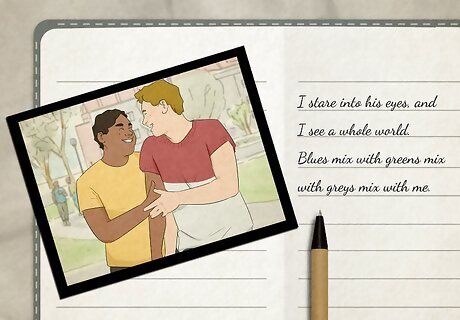
Focus on a specific, concrete memento. A good love poem doesn’t have to rely on stereotypes and super flowery language to be beautiful and touching. Instead, focus on a specific object that really reminds you of your loved one, like their favorite candy, a memorable photo, or their most-worn sweatshirt. Pondering these meaningful items and memories might make it easier to channel your emotions for your love poem. A special sweatshirt might remind you of the time you and your partner went to the beach. An old family photo might bring back special, cherished memories. The throw blanket on your couch might remind you of the time that your friend slept over.

Look to your surroundings for subtle inspiration. Find a relaxing spot to camp out for a little while, like your living room sofa or your favorite park bench. Take a few moments to really study what’s going on around you, whether it’s the sunlight touching the curtains in a special way, the wind drifting through the grass, or the way a stranger walks down the street. When you study the world in a reflective and mindful way, you might actually get some fresh inspiration for your love poem! Here are a few possibilities: Staring at your kitchen table might remind you of all the great dinnertime conversations you had with your mom. Observing crowds of people walking by might remind you of a fun night out with your best friend. Watching someone walk down the sidewalk could remind you of a special walk you went on with your grandpa.

Ask yourself what love means to you. Maybe love means someone caring about you unconditionally, or someone sharing part of their life with you. Once you’ve decided what love means and represents in your own life, ask yourself how your loved one fits into this definition. Then, channel these feelings into your poem as you begin to write. Perhaps love represents a person who’s there for you 24/7. You might think about a time your loved one dropped everything to help you during your time of need. Maybe love represents physical affection, like a big hug or a kiss on the cheek.

Get a burst of inspiration by reading some published love poems. Writing a poem may seem a bit overwhelming at first, especially if you don’t have a lot of experience. This is where reading love poems can come in handy! Instead of brainstorming your own ideas, take a moment to read the love poems of some experienced poets. Reading other people’s poems can provide a lot of new ideas, and may even help you approach your own poem in a fresh, new way. Here are a few poems you can check out: “If I am Alive To” by Charif Shanahan “Mountain Dew Commercial Disguised as a Love Poem” by Matthew Olzmann “San Antonio” by Naomi Shihab Nye “For What Binds Us” by Jane Hirshfield “The Great Fires” by Jack Gilbert
Choosing a Form

Write a loving haiku to keep things short and sweet. Haiku poems are short, non-rhyming, 3-line poems that follow a specific syllable structure: the first line has 5 syllables, the second line has 7, and the third line also has 5. If you’re feeling a little crunched for time, a haiku might be the perfect poetry form for you. An example of a loving haiku could be:Mom, you are the bestYou mean the whole world to meThanks for everything You could also write something like:I love you so muchWhat would I do without youThanks for being you

Spell out your feelings with an acrostic poem. Acrostic poems are centered around a specific word, which you write vertically on the page. Each “line” of your poem matches up with the different letters of this word. If you’re feeling a bit uninspired, an acrostic-style poem may be just what you’re looking for. You might use the person’s name as the theme for the acrostic. If you’re feeling especially creative, you could use a meaningful word like “love” or “family.” For instance, an acrostic poem based on the word “Dad” might look like: Determined to follow his dreamsAlways gives free hugsDoesn’t ever give up A poem for your friend Sara might look like:Set on her goalsAdventurousReady to face any challengeAmazing friend

Imitate a classic love poem with a Shakespearean sonnet. This special sonnet follows a very specific rhyme scheme: ABAB CDCD EFEF GG. In other words, the first and third lines, second and fourth lines, fifth and seventh lines, sixth and eighth lines, ninth and eleventh lines, tenth and twelfth lines, and thirteenth and fourteenth lines all end up rhyming. Shakespearian sonnets also follow an iambic pentameter—this means that each line of the poem has 10 total syllables, which follow a “ta-TUM ta-TUM ta-TUM ta-TUM ta-TUM ta-TUM” rhythm. In a Shakespearean sonnet, every other syllable is stressed. The classic Shakespeare line “Shall I compare thee to a summer’s day” is a great example of this. Shakespeare’s “Sonnet 147” is a great example of a romantic poem. Shakespearian sonnets are an excellent option if you’d like to try your hand at a classic love poem.

Create a concrete poem to turn your words into a picture. In a concrete poem, the words and lines of your poem resemble a specific shape. With this in mind, think about the symbol you’d like to convey in your poem, such as a heart or a star. Write your poem as you normally would, adjusting spaces and margins to create this desired shape. Check out “Fingers Remember” by Marilyn Nelson for a unique, romantic example of concrete poetry. Concrete poems are very beginner-friendly; unlike other poetry forms, you don’t have to follow a specific rhyme scheme of syllable structure.
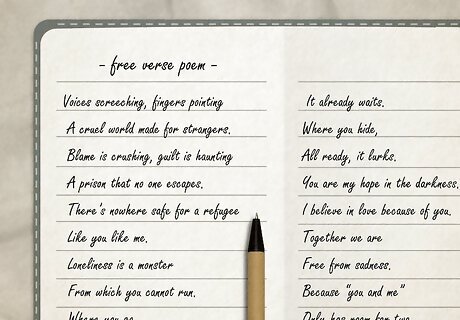
Try a free verse poem if you don’t feel like playing by the rules. In fact, free verse poetry isn’t held back by any specific rhyme scheme or syllable count. With the free verse poem, you have lots of freedom to write anything and everything you’d like. This form is a great choice if you’re a beginner poet or if you just don’t like being held down by rules and regulations. Take a look at poems like “Oh Sweethearts” by Liz Berry or “Something to Look Forward To” by John Yau for some excellent free verse examples.

Transform existing love poems into your own creation with a cento poem. A cento poem is a collage of lines from already-existing poems. If you don’t have a ton of poetry-writing experience, the cento poem might be a fun, easy option for you. Pick out some of your favorite love poems and highlight some especially poignant lines from each one. Then, “patch” these lines together into your very own poem. For example, you might make a cento poem using lines from poems like “How Do I Love Thee?” by Elizabeth Barrett Browning, “When You Are Old” by William Butler Yeats, “Come, and Be My Baby” by Maya Angelou, and “Sonnet 18” by William Shakespeare.
Using Literary Devices

Reinvent cliches into something creative and clever. Cliches are really hard to avoid, especially if you’re a beginner poet. Not to worry! Just take a closer look at the cliche and analyze what you’re really trying to say. Then, rewrite and reinvent the cliche into something that’s a little more creative, fun, and original. Instead of saying “You look as beautiful as a princess,” you could say, “You look more radiant than the rising sun.” Instead of writing, “You make time for me even when you’re as busy as a bee,” you might say, “You’ll make time for me even when the weight of the world is on your shoulders.”

Take your poem to the next level with descriptive imagery. Imagery is all about drawing a beautiful picture through the words and lines of your poem. In your writing, introduce your loved one to new sights, sounds, smells, touches, and tastes. Let every line pop off the page and add to the message you’re trying to convey. A line like “Your cheeks are dusted with stars” appeals to the sense of sight. “My heart thrums and sings” appeals to the sense of sound. “Your lips taste like honey” appeals to the sense of taste.
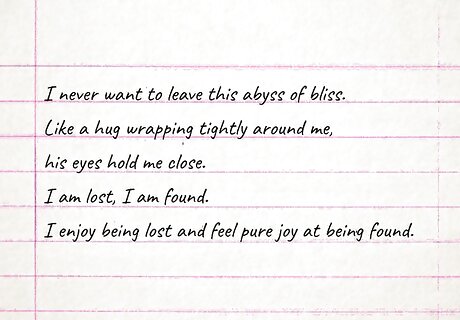
Play around with metaphors and similes. Metaphors and similes compare 2 different things to each other. The main difference is that similes make this comparison using the words “like” or “as,” while metaphors do not. Sprinkle these literary devices throughout your poem to give it a little extra depth. “She is a tulip” would be a metaphor, while “She is as fragrant as a tulip” would be a simile. “You are the sun” is a metaphor, while “You shine like the sun” is a simile.
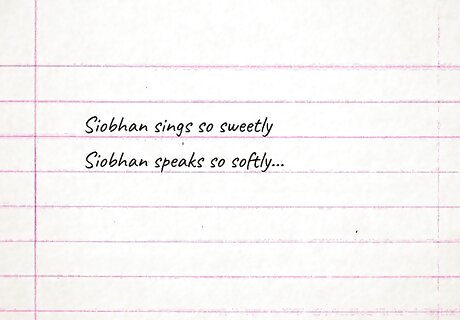
Add alliteration and assonance to your poem. Alliteration occurs when you start several words with the same consonant. Assonance follows a similar pattern, but repeats the same vowels instead of consonants. Try playing around with different words in your poem using these strategies and see what you can come up with! “Siobhan sings so sweetly” and “Billy bought a blue brooch” are examples of alliteration. “You do too” is a great example of assonance.
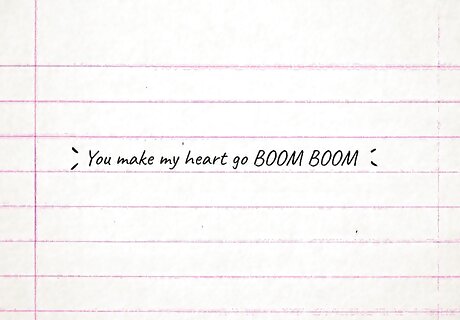
Sprinkle sound into your poem with onomatopoeia. Have you ever seen words like “bam,” “pop,” or “hiss” sprinkled into a poem? These written-out sound effects are also known as onomatopoeia, and can add a fun, creative dimension to your love poem. Brainstorm some fun, unique sound effects that will really take your love poem to the next level. Here are a few ideas to get you started: “You make my heart go pitter-patter.” “My heart thumps when you walk past.” “I barely hear the drip-drop of the rain when we’re together.”



















Comments
0 comment